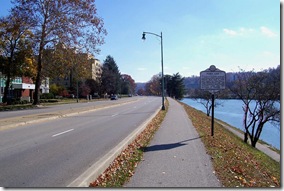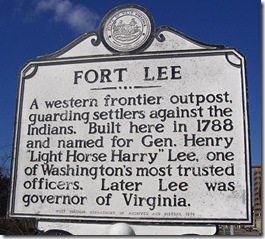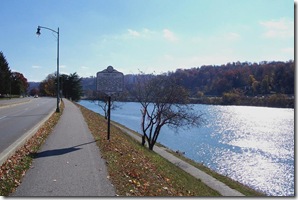Marker Text: A western frontier outpost, guarding settlers against the Indians. Built here in 1788 and named for Gen. Henry "Light Horse Harry" Lee, one of Washington's most trusted officers. Later Lee was governor of Virginia.
Location: 1100 block of Kanawha Boulevard, near junction with Brooks Street, Charleston, West Virginia next to the Kanawha river. Erected by the West Virginia Department of Archives and History in 1974.
Today's marker mentions an early frontier fort that once stood here at the intersection of Kanawha Boulevard and Brooks Street in Charleston, West Virginia.
Photo taken looking west on Kanawha Boulevard and Brooks Street is to the right. Another marker in the background is called First Gas Well. (Click any photo to enlarge)
Early settlers of the Virginia frontier, now West Virginia, began moving south of the Potomac River about 1719. The Native American Indians had misgivings about the early settlers, but since their arrival was gradual and in small numbers, they at first had a degree of tolerance. For the first thirty years the settlers and Indians lived to some extent in peace and tolerance of one another, often trading.
With the appearance of the French in the Ohio Valley the circumstances changed. The French attempted to use the Indians in order to remove the English settlers from the frontier and gain control which lead to the French and Indian War in 1754 and ended by 1762. In March of 1756, the Virginia Assembly authorized the erection of a chain of defenses on the west. Colonel George Washington was placed in charge. Washington's office for planning these defenses was in Winchester, VA. A chain of forts about twenty miles apart, designed to afford some protection for the settlers, were constructed during the next year.
Photo taken looking east with the Kanawha River on the right and Kanawha Boulevard on the left.
Beginning at the head of the Ohio River at Pittsburgh and swinging east to Cumberland, Maryland, roughly following the Allegheny Mountains to North Carolina, a series of forts were first established. Many of these early forts are now simply remembered by a historical marker or a simple stone monument located near the original site. Many of these forts were the scenes of tragic episodes in which numerous lives were lost, especially in the region now along the South Branch of the Potomac River in West Virginia.
In the ten years, following the French and Indian War created a relative degree of peace until 1774 with a new outbreak between settlers and the Indians particularly as more settlers moved further west. This new outbreak of hostilities was called Dunmore's War in which the most important event was the Battle of Point Pleasant along the Ohio River. A new line of defensive forts were created further west following the Ohio River and along the Kanawha River. A long series of forts, stockades and blockhouses were located at strategic locations to protect the settlers.
In April 1788, Col. George Clendenin was ordered to construct a military outpost near the confluence of the Kanawha and Elk rivers as a defense against the Indians. As a result, he established the first permanent settlement within the present boundaries of Charleston, WV. A fort, named Clendenin’s Fort or Fort Lee, in honor of Gen. Richard Henry ‘‘Light Horse Harry’’ Lee, was built on land Clendenin had purchased from Judge Cuthbert Bullitt of Prince William County, Virginia.
 The site offered a good spot for a canoe landings and a vantage point above the river. Completed in May 1788, the fort structure was about 36 feet long and 18 feet wide, with a height of about 18 feet. A stockade, constructed of logs placed upright and set side by side in ditches, was about 250 by 175 feet.
The site offered a good spot for a canoe landings and a vantage point above the river. Completed in May 1788, the fort structure was about 36 feet long and 18 feet wide, with a height of about 18 feet. A stockade, constructed of logs placed upright and set side by side in ditches, was about 250 by 175 feet.
After Fort Lee was constructed and achieved its purpose in protecting the settlers and helped to establish the Charleston settlement. Col. Clendenin was able to persuade the Virginia legislature to create Kanawha County from the western parts of Greenbrier and Montgomery counties.
The stockade lasted until 1815, and the blockhouse was used as a residence for many years. John P. Hale purchased the original lot and the blockhouse in 1872 and moved the building to the corner of Virginia and Brooks streets, which later burned down in 1891. This marker and another monument erected in 1915 at the site marking the site of Charleston’s beginnings is all that remains.



No comments:
Post a Comment